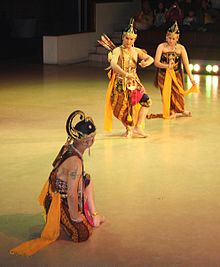
Back Wayang wong BAN Wayang wong ID Ringgit tiyang JV Wayang Wong Dutch Ваянг вонг Russian Wayang wong Priangan Sundanese 哇揚翁戲 Chinese
| Wayang wong | |
|---|---|
 | |
| Types | Traditional |
| Originating culture | Indonesia (Javanese and Balinese) |
| Wayang | |
|---|---|
| Country | Indonesia |
| Reference | 00063 |
| Region | Asia and the Pacific |
| Inscription history | |
| Inscription | 2008 (3rd session) |
| List | Representative |
| Wayang wong |
|---|
|
| Burma |
| Cambodia |
| Indonesia |
|
| Laos |
| Malaysia |
| Philippines |
| Singapore |
| Thailand |
|
| Vietnam |
Wayang wong (Javanese: ꦮꦪꦁꦮꦺꦴꦁ (in the ngoko register)),[1] also known as wayang orang (lit. 'human wayang'), is a type of classical Javanese and Balinese dance theatrical performance with themes taken from episodes of the Ramayāna or Mahabharāta. Performances are stylised, reflecting Javanese court culture:
Wayang wong dance drama in the central Javanese Kraton (royal court) of Yogyakarta represents the epitome of Javanese aesthetic unity. It is total theatre involving dance, drama, music, visual arts, language, and literature. A highly cultured sense of formality permeates every aspect of its presentation.[2]
Despite being closely associated with Javanese and Balinese tradition, variants of wayang wong dance drama can also be found in neighboring Javanese ethnic traditions, including Sundanese tradition.
- ^ Robson & Wibisono 2002, pp. 803–804.
- ^ Garrett Kam (Spring 1987). "Wayang Wong in the Court of Yogyakarta: The Enduring Significance of Javanese Dance Drama". Asian Theatre Journal. 4 (1): 29–51. doi:10.2307/1124435. JSTOR 1124435.
